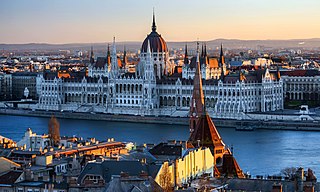
Budapest is the capital and most populous city of Hungary. It is the ninth-largest city in the European Union by population within city limits and the second largest city on the Danube river. The city has an estimated population of 1,752,286 over a land area of about 525 square kilometres. Budapest, which is both a city and municipality, forms the centre of the Budapest metropolitan area, which has an area of 7,626 square kilometres and a population of 3,303,786. It is a primate city, constituting 33% of the population of Hungary.

Buda is the part of Budapest, the capital city of Hungary, that lies on the western bank of the Danube. Historically, “Buda” referred only to the royal walled city on Castle Hill, which was constructed by Béla IV between 1247 and 1249 and subsequently served as the capital of the Kingdom of Hungary from 1361 to 1873. In 1873, Buda was administratively unified with Pest and Óbuda to form modern Budapest.

Kaposvár is a city with county rights in southwestern Hungary, south of Lake Balaton. It is one of the leading cities of Transdanubia, the capital of Somogy County, and the seat of the Kaposvár District and the Roman Catholic Diocese of Kaposvár.

Lajos Kossuth de Udvard et Kossuthfalva was a Hungarian nobleman, lawyer, journalist, politician, statesman and governor-president of the Kingdom of Hungary during the revolution of 1848–1849.

Count István Széchenyi de Sárvár-Felsővidék was a Hungarian politician, political theorist, and writer. Widely considered one of the greatest statesmen in his nation's history, within Hungary he is still known to many as "the Greatest Hungarian".

Székesfehérvár, known colloquially as Fehérvár, is a city in central Hungary, and the country's ninth-largest city. It is the regional capital of Central Transdanubia, and the centre of Fejér County and Székesfehérvár District. The area is an important rail and road junction between Lake Balaton and Lake Velence.
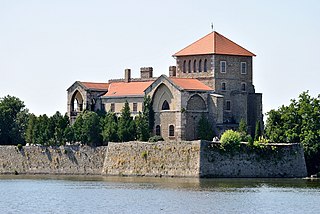
Tata is a town in Komárom-Esztergom County, northwestern Hungary, 9 km (6 mi) northwest of the county town Tatabánya.
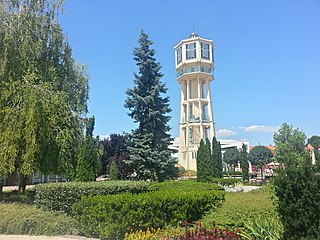
Siófok is a town in Somogy County, Hungary on the southern bank of Lake Balaton. It is the second largest municipality in Somogy County and the seat of Siófok District. It covers an area of about 124.66 km2 between Lake Balaton, the Mezőföld and the Outer Somogy-Hills. Lying at the firth of the Sió Channel, it serves as the most important logistic station for goods between Lake Balaton and the River Danube.
Hungarian Canadians are persons in Canada of Hungarian ancestry. According to the 2016 Census, there are 348,085 Canadians of Hungarian ancestry. The Hungarian minority is the 24th largest ethnic group of Canada. The bulk of Hungarian immigration occurred after World War II, with the wave peaking after the 1956 Hungarian revolution against communist rule, when over 100,000 Hungarian refugees went to Canada. The Hungarian Canadian community is among the country's multiple ethnicities; Canada is one of the top five countries of the Hungarian diaspora.

Transdanubia is a traditional region of Hungary. It is also referred to as Hungarian Pannonia, or Pannonian Hungary.
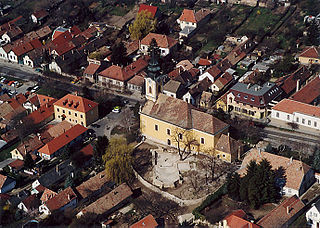
Budakeszi is a town in Pest County, in the Budapest metropolitan area, Hungary. It is located beyond the János Hill at the western city limits of Budapest, about 12 km (7 mi) west of the Zero Kilometre Stone in the city centre. A popular recreational area, the landscape is characterized by forests, predominantly oaks, by vineyards and by orchards.

Borzavár is a village in Veszprém county in Hungary in Zirc District near the town of Zirc in the High Bakony Mountains. From the village and the surrounding countryside the twin caps of the Koris-hill and the Kék-hill create a beautiful panoramic view.

The Hungarian Revolution of 1848, also known in Hungary as Hungarian Revolution and War of Independence of 1848–1849 was one of many European Revolutions of 1848 and was closely linked to other revolutions of 1848 in the Habsburg areas. Although the revolution failed, it is one of the most significant events in Hungary's modern history, forming the cornerstone of modern Hungarian national identity—the anniversary of the Revolution's outbreak, 15 March, is one of Hungary's three national holidays.

Rakacaszend is a village in Borsod-Abaúj-Zemplén county, Hungary. It is located in the hilly Cserehát region. The village is famous for its medieval church.
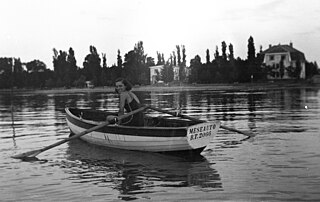
Balatonszabadi is a village in Somogy county, Hungary.
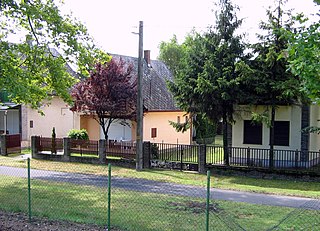
Balatonberény is a village in Somogy county, Hungary, with a popular nudist beach. The country village had a population of 1,200 in 2011.

The city of Budapest was officially created on 17 November 1873 from a merger of the three neighboring cities of Pest, Buda and Óbuda. Smaller towns on the outskirts of the original city were amalgamated into Greater Budapest in 1950. The origins of Budapest can be traced to Celts who occupied the plains of Hungary in the 4th century BC. The area was later conquered by the Roman Empire, which established the fortress and town of Aquincum on the site of today's Budapest around AD 100. The Romans were expelled in the 5th century by the Huns, who were challenged by various tribes during the next several centuries. The Hungarian conquest of the Carpathian Basin started at the end of the 9th century, and the Kingdom of Hungary was established at the end of the 11th century.
The following is a timeline of the history of the city of Budapest, Hungary.
Iván Boldizsár was a Hungarian journalist, writer and editor of several Hungarian publications, periodicals and newspapers.

















